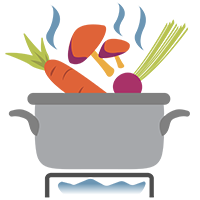Ojibwe Menwaagamig Juice Drink

Ojibwe Menwaagamig Juice Drink
Indigenous cuisine often packs a flavorful punch, and that's absolutely the case with this sweet, berry-licious drink!
Happy & Healthy Cooking,
Fun-Da-Mentals Kitchen Skills
- measure :
to calculate the specific amount of an ingredient required using a measuring tool (like measuring cups or spoons).
- pour :
to cause liquid, granules, or powder to stream from one container into another.
- stir :
to mix together two or more ingredients with a spoon or spatula, usually in a circle pattern, or figure eight, or in whatever direction you like!
- strain :
to separate liquids from solid foods or remove bigger food particles from smaller particles using a perforated or porous device like a strainer, sieve, colander, or cheesecloth.
Equipment Checklist
Ingredients
Ojibwe Menwaagamig Juice Drink
- 3 C water
- 2 C blueberries, strawberries, or raspberries (your choice!)
- 1/3 C honey or white sugar
- 2 C ice
Instructions
Ojibwe Menwaagamig Juice Drink
measure + blend + strain
Measure and combine 1 cup water, 2 cups berries of your choice, and 1/3 cup honey in a pitcher. Blend the fruit mixture until smooth. While blending, slowly pour in the remaining 2 cups of water. Pour over 2 cups of ice as is, or first strain the juice to remove any pesky seeds. Enjoy!
recipe tidbit
You can make this drink with any fruit! This recipe was the original way Native Americans made fruit juices.

Hi! I'm a Berry!
"To be specific, I'm an edible berry. We might be sweet or sour, colorful, juicy, and delicious! People around the world eat us alone, with other foods, and in jams, preserves, and pies! Yum! Did you know that bananas, pumpkins, tomatoes, and watermelons are technically berries!"
- Thousands of years ago, before crops were domesticated, hunter-gatherers picked wild berries, an activity people still enjoy doing today.
- Berry cultivation may have begun as early as the 10th century in Japan, the 14th century in Europe, and the 18th century in the United States.
- The word "berry" comes from the Old English "berie," from the German "beere."
- Globally, strawberries are grown twice the amount of any other berry, although strawberries, blackberries, and raspberries are not actual berries, botanically speaking—they are aggregate fruits.
- Botanical berries include blueberries, cranberries, elderberries, gooseberries, lingonberries, and persimmons.
- Berries are a wonderful snack eaten by themselves or added to cold and hot cereal. But they are equally delightful when made into preserves, jams, and sauces. In addition, berries are often used in baked goods like cakes, cobblers, muffins, and pies.
- Berries are often called a "superfood" and are recommended by doctors and nutritionists for a healthy diet. They are high in antioxidants and fiber, and many have essential nutrients like vitamin C, helping to protect against cancer and chronic disease.
Let's Learn About Indigenous Americans!

- Indigenous Americans are related to people who populated the Americas before the arrival of European settlers in the late 15th century.
- Historians previously thought the Clovis people were the first to arrive and dwell in the Americas. They were paleolithic hunter-gatherers who crossed over the Beringian land bridge from Siberia to Alaska about 11,500 years ago, during the last ice age. However, archaeological evidence in Chile and Mexico indicates that humans reached the Americas earlier, sometime between 15,000 and 20,000 years ago.
- Many indigenous groups living in North and South America were hunter-gatherers, and others were farmers or fishers. Some lived in highly-developed cities, cultures, and empires, like the Aztecs and Incas. Others lived more nomadic lives, following the herds, like bison.
- Although indigenous populations decreased dramatically during European colonization and expansion, native people still live in many parts of the Americas. There are large numbers of indigenous inhabitants in Bolivia, Canada, Chile, Ecuador, Guatemala, Mexico, Peru, and the United States.
- Indigenous languages are still spoken in many of these countries. For example, Mexico recognizes 63 indigenous languages, with the Nahuatl language spoken by over one million people. In Peru, Quechua is spoken by almost 14 percent of the population.
- The indigenous peoples of Canada consist of the First Nations, Inuit, and Métis (mixed First Nations and European, mostly French). The previously-used terms of Indian and Eskimo are considered disrespectful and offensive.
- Native Americans in the United States make up a little over one percent of the country's population. In the 2020 census, almost 10 million people identified as fully or partially Native American or Native Alaskan.
- In 2021, Deb Haaland was named Secretary of the Interior, the first Native American to be part of the president's cabinet. As of 2022, eight indigenous Americans serve in the US Congress.
- Indigenous cuisine varies across North and South American countries, and the following are examples of foods from a few different regions.
- In the northern regions of Canada, Western food is expensive to import, so they rely on traditional "country" foods, like berries, fish, caribou, moose, geese, and seals.
- In the Eastern Woodlands, the Three Sisters (squash, corn, and beans), maple syrup, cornmeal, blueberries, cranberries, and nuts are prominent foods.
- In the Southwest, diets include corn, squash, beans, pine nuts, sunflower seeds, trout, turkey, and venison.




